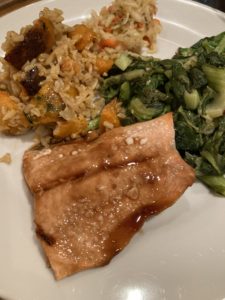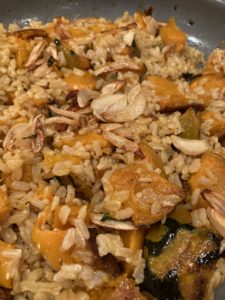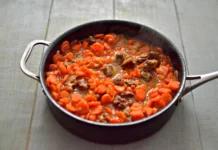
This dinner came together rather nicely last week. I had some salmon, bok choy, leftover brown rice and leftover roasted kabocha squash.
A Chinese flavor palate suggested itself, but I wanted to do something more than spritz soy on the salmon.
The sauce I created was a corker — I was practically licking the plate when we finished.
Repurposing the rice and roasted squash was a good move; I loathe waste, but I equally detest the boredom of reheated leftovers. By mixing them up and infusing them with toasted garlic, the two items were completely reinvented, and there was not a hint of monotony in the air. Here’s what I did:
Salmon with Caramelized Soy Sauce
Serves 4
This sauce was easy to make, and it delivered complexity and depth beyond the sum of its parts. By essentially caramelizing the sauce, the flavors concentrated and melded in a way that was pretty darn amazing. I had intended it for the fish, but when that was gone, I found myself pouring it out of the dish onto my rice … always a sign that the recipe was a success.
For the sauce:
¼ cup brown sugar
¼ cup soy sauce
¼ cup white wine
½ cup water
For the salmon:
4 salmon fillets
2 teaspoons of the sauce
In a small saucepan, mix all the ingredients and bring them to a boil. Lower the heat, and continue simmering until the sauce is reduced and thickened into a syrup, about 15 minutes.
Heat your oven to 300 degrees F.
Line a baking dish with a piece of parchment large enough to loosely wrap the salmon. Place the salmon on the parchment, and spoon a bit of the sauce over each fillet. Wrap the salmon with the parchment, and bake 20-25 minutes until done. Note: If you do not have parchment, use a baking dish with a lid, or cover it tightly with foil.
When the salmon is done, remove it from the parchment and pour the remaining sauce over the fish.

Toasted Garlic Rice and Kabocha Squash
Serves 4
Don’t roast squash just for this dish — the idea is that you can repurpose leftover cooked veggies into something delicious and unique with this preparation. Cabbage, broccoli, carrots, greens, etc. can all be used to great effect in this manner.
4 large garlic cloves, sliced very thinly
2 cups cooked rice
2 cups cooked kabocha squash or another vegetable, cut into bite-sized pieces
2 tablespoons vegetable or canola oil
1 teaspoon sesame oil
Pinch of salt
Place the garlic, oils and salt in a large skillet and heat to toast the garlic, stirring and watching it carefully. When the garlic is golden brown and crispy, remove it from the oil and set it aside.
Add the rice and vegetables to the seasoned oil, and stir fry to allow the flavor to infuse and to let some of the rice and veggies crisp a bit.
Taste and add salt, if needed. Before serving, sprinkle the toasted garlic over the dish.
Bok Choy with Ginger and Garlic
Serves 4
The addition of a small amount of honey to this dish tamped down the bitterness; I am not sure if my batch was particularly strong, or whether a sharper flavor is common for bok choy at this point in the season.
2 large bunches bok choy, rinsed well and chopped coarsely
2 teaspoons grated fresh ginger
2 cloves garlic crushed
Sprinkle of red pepper flakes
Pinch of salt
1 tablespoon vegetable or canola oil
1 teaspoon honey,
if needed
In a large skillet, heat the oil and sauté the garlic, ginger, salt and pepper flakes until fragrant. Add bok choy and turn over frequently until wilted and soft, about 6 minutes.
Taste it; if the greens are bitter, add the honey and mix well. If not, omit the honey and serve.





